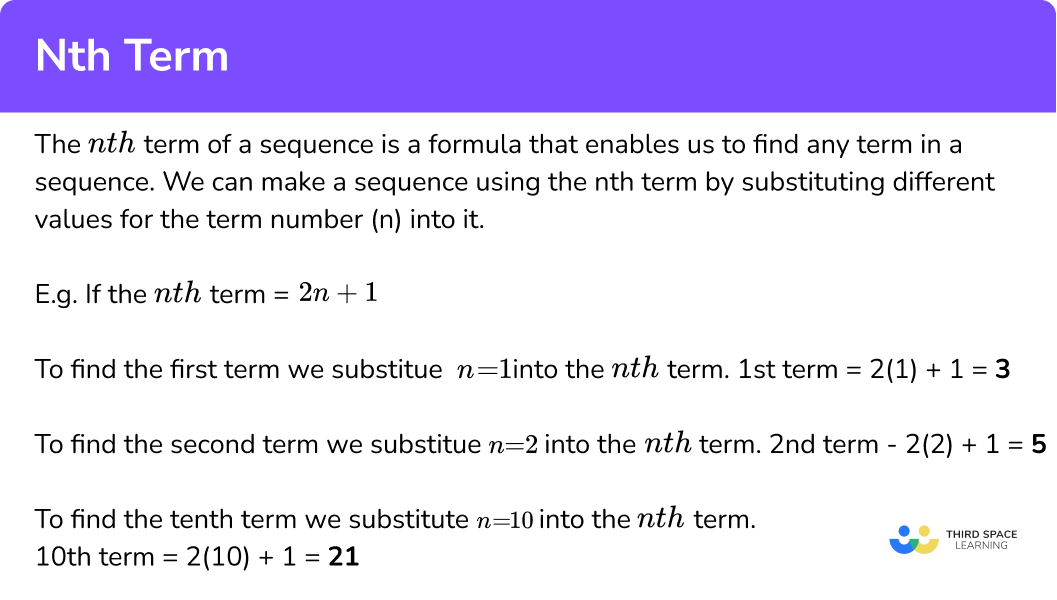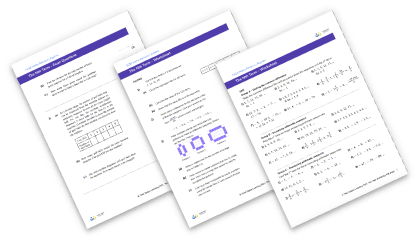Find a Formula for the Nth Term an of the Sequence Assuming That the Indicated Pattern Continues
One to one maths interventions built for KS4 success
Weekly online one to one GCSE maths revision lessons now available
Learn more
In order to access this I need to be confident with:
Addition and subtraction
Multiplication and division
Substitution
This topic is relevant for:

Nth Term Of A Sequence
Here we will learn about how to find the
At the end you'll find nth term worksheets based on Edexcel, AQA and OCR exam questions, along with further guidance on where to go next if you're still stuck.
What is the nth term?
The
We can make a sequence using the
To find the 10th term we would follow the formula for the sequence but substitute 10 instead of '
For example if the
- To find the first term we substitute
n = 1 into then th term.
1st term
- To find the second term we substitute
n = 2 into then th term.
2nd term
- To find the third term we substitute
n = 3 into then th term.
3rd term
- To find the tenth term we substitute
n = 10 into then th term.
10th term = 2(10) + 1 = 21
Below are a few examples of different types of sequences and their
| Type of Sequence | Example | nth Term |
|---|---|---|
| Arithmetic | 6, 2, -2, -6, -10, ... | 10-4n |
| Geometric | 1, 2, 4, 8, 16, 32, ... | 2{n-1} |
| Quadratic | 3, 9, 19, 33, 51, ... | 2n^{2}+1 |
| Cubic | 2, 22, 78, 188, 370, ... | 3n^{3}-n |
In this lesson, we will look specifically at finding the
What is the nth term?


nth term worksheet

Get your free nth term worksheet of 20+ questions and answers. Includes reasoning and applied questions.
DOWNLOAD FREE

nth term worksheet

Get your free nth term worksheet of 20+ questions and answers. Includes reasoning and applied questions.
DOWNLOAD FREE
How to find the nth term
The nth term of an arithmetic sequence is given by :
a_{n}=a_{1}+(n-1) d
To find the nth term, first calculate the common difference,
Next multiply each term number of the sequence
Then add or subtract a number from the new sequence to achieve a copy of the sequence given in the question.
This will give you the
To summarise, in order to find the
- Find the common difference for the sequence.
- Multiply the values for
n = 1, 2, 3 . - Add or subtract a number to obtain the sequence given in the question.
Explain how to find the nth term of an arithmetic sequence in 3 steps

nth term formula
The nth term formula for an arithmetic sequence is a_n=a_1+(n-1)d
Where,
a_{n} is the n^{th} term (general term)
a_{n} is the first term
n is the term position
d is the common difference
- The nth term formula for a geometric sequence is:
a_n=a_1(r)^{n-1}
Where,
a_{n} is the n^{th} term (general term)
a_{1} is the first term
r is the common ratio
- The nth term formula for a quadratic sequence is:
an^2+bn+c
Where,
a, b and c are constants (numbers on their own)
n is the term position
a + b + c is the first term
3a + b is the first difference between
2a is the second difference
nth term examples
Example 1: find the nth term for an increasing arithmetic sequence
Find the
- Find the common difference for the sequence.
Here,
The common difference
2 Multiply the values for
Here, we generate the sequence
3 Add or subtract a number to obtain the sequence given in the question.
The
Example 2: find the nth term for a decreasing sequence, including negative numbers
Find the
Find the common difference for the sequence.
Here,
The common difference
Multiply the values for n = 1, 2, 3, … by the common difference.
Here, we generate the sequence
Add or subtract a number to obtain the sequence given in the question.
The
Example 3: find the nth term of a sequence including decimals.
Find the
Find the common difference for the sequence.
Here,
The common difference
Multiply the values for n = 1, 2, 3, … by the common difference.
Here, we generate the sequence
Add or subtract a number to obtain the sequence given in the question.
The
term of this sequence is
\[\frac{3 n-1}{10}\]
Example 4: find the nth term of a sequence including negatives and decimals
Find the
Find the common difference for the sequence.
Here,
The common difference
Multiply the values for n = 1, 2, 3, … by the common difference.
Here, we generate the sequence
Add or subtract a number to obtain the sequence given in the question.
The
Example 5: find the nth term of a sequence including fractions
Find the
\[\frac{1}{4}, \frac{5}{8}, 1,1 \frac{3}{8}, 1 \frac{3}{4}, \ldots\]
Find the common difference for the sequence.
Here
\[\frac{5}{8}-\frac{1}{4}=\frac{5}{8}-\frac{2}{8}=\frac{3}{8}\]
The common difference
\[d=\frac{3}{8}\]
Multiply the values for n = 1, 2, 3, … by the common difference.
Here, we generate the sequence
\[\frac{3 n}{8}=\frac{3}{8}, \frac{3}{4}, 1 \frac{1}{8}, 1 \frac{1}{2}, 1 \frac{7}{7}, \ldots\]
\[\left ( \text{the multiples of }\frac{3}{8} \right ).\]
Add or subtract a number to obtain the sequence given in the question.
The
\[\frac{3 n}{8}-\frac{1}{8} \text { or } \frac{3 n-1}{8}\]
Example 6: find the nth term when interpreting a pattern
Using the patterns below, write an expression for the number of lines in pattern
Find the common difference for the sequence.
By counting the number of sides we can see that the first term in the sequence is
The second term in the sequence is
The next term
Here,
The common difference
Multiply the values for n = 1, 2, 3, … by the common difference.
Here, we generate the sequence
Add or subtract a number to obtain the sequence given in the question.
The
Common misconceptions
- The common difference is used as the constant instead of the multiplier
For example, the sequence
- The
n th term is incorrectly simplified
For example, if the
- For decreasing sequences, the
n th term has a positive common difference
For example, taking the decreasing sequence
Practice nth term questions




\begin{array}{l} 4 \times 1 – 7 = -3\\\\ 4 \times 2 – 7 = 1 \\\\ 4 \times 3 – 7 = 5 \end{array}




It is an arithmetic sequence meaning the difference between each term is the same.
15.9-8.7 = 7.2 so the difference between each term is 7.2 .
8.7-7.2=1.5 therefore the first term is 1.5 .




The common difference here is 5 so it is 5n .
To get from 5n to our sequence we need to add 3 so our sequence is 5n+3 .




The common difference is -10 so it is -10n .
We do not need to add or subtract anything here so the nth term is just -10n .




The number of petals on the first three flowers are 5, 7 and 9 .
We need to find the n^{th} term of this sequence.
The common difference is 2 so it is 2n .
We need to add 3 to the sequence 2n so the expression is 2n+3 .




Around the first three pools, the number of tiles are 8, 12 and 16 .
The n^{th} formula for this sequence is 4n+4.
Substituting n = 30 , 4 \times 30 + 4 = 124 .




The common difference is \frac{1}{3} so it is \frac{1}{3} n .
Another way of writing this is \frac{n}{3} .
nth term GCSE questions
1. A sequence of patterns is made using triangles.
(a) What is the n^{th} term formula for the number of triangles?
(b) How many dark purple triangles would there be in pattern number 100 ?
(3 marks)
Show answer
(a)
Sequence 1, 3, 5, 7 – common difference is 2
(1)
2n – 1
(1)
(b)
99 (one less than the pattern number)
(1)
2. (a) Write down an expression for the n^{th} term of the following sequence:
-4, -1, 2, 5, 8, ….
(b) Is the number 101 in this sequence? Show how you decide.
(4 marks)
Show answer
(a)
Common difference is 3
(1)
3n-7
(1)
(b)
3n − 7 = 101
(1)
\begin{aligned} 3n&=108\\\\ n&=36 \end{aligned}
Yes it is the 36th term
(1)
3. The n^{th} of a sequence is 2n + 3 .
The n^{th} of a different sequence is 5n − 2 .
There are two numbers under 30 that appear in both sequences. What are the two numbers?
(3 marks)
Show answer
2n + 3: 5, 7, 9, 11, 13, 15, 17, 19, 21, 23, 25, 27, 29,..
(1)
5n − 2: 3, 8, 13, 18, 23, 28, …
(1)
13 and 23
(1)
Learning checklist
You have now learned how to:
- Recognise arithmetic sequences
- Find the nth term
Still stuck?
Prepare your KS4 students for maths GCSEs success with Third Space Learning. Weekly online one to one GCSE maths revision lessons delivered by expert maths tutors.

Find out more about our GCSE maths revision programme.
We use essential and non-essential cookies to improve the experience on our website. Please read our Cookies Policy for information on how we use cookies and how to manage or change your cookie settings.Accept
Source: https://thirdspacelearning.com/gcse-maths/algebra/nth-term/
0 Response to "Find a Formula for the Nth Term an of the Sequence Assuming That the Indicated Pattern Continues"
Enregistrer un commentaire